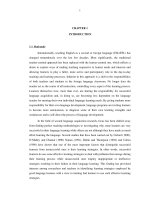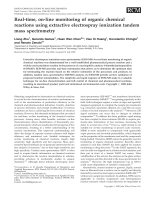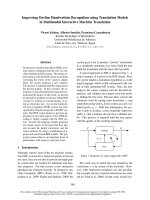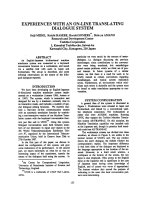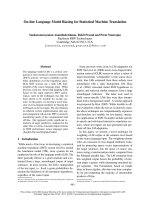Capstone e people on line people strategies
Bạn đang xem bản rút gọn của tài liệu. Xem và tải ngay bản đầy đủ của tài liệu tại đây (1.16 MB, 107 trang )
09.03 PEOPLE
E-People
E-People
Sue Weekes and Scott Beagrie
■ Fast track route to mastering online people strategies
■ Covers the key areas of online people strategies, including how
Web-based technology can streamline and automate traditional
HR tasks, transform HR into a more strategic function and help to
build a more effective and motivated workforce
■ Examples and lessons from some of the world’s most successful
businesses, including BP, Exult, Getty Images, IBM, ICL and
Oracle, and ideas from the smartest thinkers, including David
Ulrich, Peter Drucker, David Cannon, Christopher Boone and John
Sullivan
PEOPLE
resources guide
09.03
PEOPLE
■ Includes a glossary of key concepts and a comprehensive
E-People
Sue Weekes and Scott Beagrie
■ Fast track route to mastering online people strategies
■ Covers the key areas of online people strategies, including
how Web-based technology can streamline and automate
traditional HR tasks, transform HR into a more strategic
function and help to build a more effective and motivated
workforce
■ Examples and lessons from some of the world’s most
successful businesses, including BP, Exult, Getty Images,
IBM, ICL and Oracle, and ideas from the smartest thinkers,
including David Ulrich, Peter Drucker, David Cannon,
Christopher Boone and John Sullivan
PEOPLE
resources guide
09.03
■ Includes a glossary of key concepts and a comprehensive
Copyright Capstone Publishing 2002
The right of Sue Weekes and Scott Beagrie to be identified as the authors of this
work has been asserted in accordance with the Copyright, Designs and Patents
Act 1988
First published 2002 by
Capstone Publishing (a Wiley company)
8 Newtec Place
Magdalen Road
Oxford OX4 1RE
United Kingdom
All rights reserved. No part of this publication may be reproduced, stored in a
retrieval system, or transmitted, in any form or by any means, electronic, mechanical, including uploading, downloading, printing, recording or otherwise, except
as permitted under the fair dealing provisions of the Copyright, Designs and
Patents Act 1988, or under the terms of a license issued by the Copyright
Licensing Agency, 90 Tottenham Court Road, London, W1P 9HE, UK, without
the permission in writing of the Publisher. Requests to the Publisher should be
addressed to the Permissions Department, John Wiley & Sons, Ltd, Baffins Lane,
Chichester, West Sussex, PO19 1UD, UK or e-mailed to
or faxed to (+44) 1243 770571.
CIP catalogue records for this book are available from the British Library
and the US Library of Congress
ISBN 1-841123-463
This title is also available in print as ISBN 1-84112-345-5
Substantial discounts on bulk quantities of ExpressExec books are available
to corporations, professional associations and other organizations. Please
contact Capstone for more details on +44 (0)1865 798 623 or (fax) +44
(0)1865 240 941 or (e-mail)
Introduction to
ExpressExec
ExpressExec is 3 million words of the latest management thinking
compiled into 10 modules. Each module contains 10 individual titles
forming a comprehensive resource of current business practice written
by leading practitioners in their field. From brand management to
balanced scorecard, ExpressExec enables you to grasp the key concepts
behind each subject and implement the theory immediately. Each of
the 100 titles is available in print and electronic formats.
Through the ExpressExec.com Website you will discover that you
can access the complete resource in a number of ways:
» printed books or e-books;
» e-content – PDF or XML (for licensed syndication) adding value to an
intranet or Internet site;
» a corporate e-learning/knowledge management solution providing a
cost-effective platform for developing skills and sharing knowledge
within an organization;
» bespoke delivery – tailored solutions to solve your need.
Why not visit www.expressexec.com and register for free key management briefings, a monthly newsletter and interactive skills checklists.
Share your ideas about ExpressExec and your thoughts about business
today.
Please contact for more information.
Contents
Introduction to ExpressExec
09.03.01
09.03.02
09.03.03
09.03.04
09.03.05
09.03.06
09.03.07
09.03.08
09.03.09
09.03.10
Why Online People Strategies are Important
The E-People Matrix
Evolution: The Human Resources Heritage
Technology: Rip it Out and Start Again?
Globalization – ‘‘. . . The Seamless Digital
Workplace’’
The State of the Art: The World of Work, but
Not as We Know it
Case Studies
Key Concepts and Thinkers
References and Resources
Ten Steps to Making it Work
Frequently Asked Questions (FAQs)
v
1
5
11
21
31
41
55
71
81
91
99
09.03.01
Why Online People
Strategies are Important
This first chapter introduces the premise that, with people now widely
considered to be the only differentiator in today’s competitive marketplaces, old-style human resources management cannot be relied upon
to create and retain the necessary dynamic and agile workforces. It
explains how managers must look to new, online people strategies to
develop and build the workforces for tomorrow.
2
E-PEOPLE
POWER TO THE PEOPLE
In the last 20 years, organizations have considered first capital and then
technology as the main competitive differentiators. Throughout this
period, human resources (HR) departments have also been responsible
for peddling two hoary clich´es: ‘‘our people are our best asset’’ and
‘‘empowerment.’’ These were little more than platitudes intended to
disguise the fact that managing was primarily about numbers and not
people.
In the last two years, the HR rhetoric has given way to reality and
people are now widely considered as the only differentiator in a highly
competitive marketplace. And it is how well they are managed that
is likely to determine a company’s future competitive advantage. But
organizations need to wake up to the fact that, in order to release and
fulfill the human potential, they must eradicate the excessive bureaucracy and inappropriate processes that have for so long surrounded the
management of people.
The recent dotcom boom has heralded the rise of a new generation
of young workers, who are exerting a great deal of influence on the
future shape of organizations. They are techno-savvy, want work to
be highly stimulating, but equally are more interested in achieving the
correct balance of work and life than kow-towing to the wishes of
any manager. They want to work, but it has to be on their terms.
US business strategist and change agent, Don Tapscott, sums up their
attitude as the network generation or N-gen mentality. ‘‘This generation
is exceptionally curious, self-reliant, and contrarian,’’ he says. ‘‘It is
smart, focused, able to adapt, high in self-esteem and has a global
orientation. It will create huge pressure for radical change in existing
companies.’’
These societal changes, combined with a global skills shortage,
means that highly talented individuals of any age are calling the shots
and employers need to market themselves to these people. At the
same time, because of intense competition and the downturn in the
economy, it’s imperative that organizations improve efficiencies, optimize performance, and streamline their businesses.
The paradigm shift in the employer/employee relationship does not
naturally map on to the people management systems and infrastructures
that were put in place decades ago. It is not enough simply to have a
WHY ONLINE PEOPLE STRATEGIES ARE IMPORTANT
3
go-faster version of the old HR model. To satisfy the demands of a smart,
focused, flexible workforce, an organization needs to be similarly agile
in its approach and its processes.
Ironically, the technology that was perceived as the differentiator in
the old employer model is now the facilitator and delivery mechanism
for the new one. E-people sets out to examine the online people
strategies that make a difference in finding, securing, stimulating, and
retaining the talent that organizations so desperately seek.
09.03.02
The E-People Matrix
» In simple terms, online people strategies are a mixture of Internet- and
intranet-enabled functions that can help to recruit and retain, train,
manage, motivate, and improve the performance of the workforce.
» Self-service is one of the most significant developments to hit people
management; it empowers the workforce, cuts costs, and frees up
time for the HR manager to be strategic.
» B2E services expand e-HR to take in everything employees need to
do their job better – this may include providing online access to shop
at work.
» Employee portals should be seen as the hub of any online people
strategy. They can start small and build into a gateway for a host of
applications.
» Beware the hype – remember how disappointing online job sites
were when they first appeared. The approach should always be
‘‘How can I use that technology?,’’ not ‘‘What technology can I use?’’
6
E-PEOPLE
E-people doesn’t have the luxury of a single, all-encompassing definable term that transforms into a natty acronym to slip seamlessly
into the management lexicon. What words could possibly sum up
a swath of technologies and applications that range from Websites
designed to sniff out a dog walker for the busy executive to an allsinging, all-dancing, integrated-e-HR self-service system that empowers
the workforce and releases the HR department from its administrative
drudgery?
Several terms are bandied around which go some way towards
identifying what is being talked about but, in simple terms, the online
people strategies discussed in E-people can be explained as a suite
of Internet- and intranet-enabled functions that help to recruit and
retain, train, manage, motivate, and raise the performance of the
workforce. The chances are that they will also allow management
to shave costs considerably. These processes comprise traditional,
transactional HR functions, which can be performed online, plus
a range of strategic Web-enabled tools that are genuinely capable
of giving a company a competitive edge if implemented and used
properly.
A deliberate decision has been taken by the authors not to use the
term e-HR (electronic-HR) as a catch-all. While e-HR is fairly central to
the plot, and will frequently crop up throughout this book, it doesn’t
always carry with it the correct connotations to encompass the more
strategic people management technologies that are helping to align HR
more closely with a company’s core business.
‘‘e-HR means a lot of things,’’ says David Ulrich, associate professor of
business administration at the University of Michigan Business School
and named by Business Week as one of the world’s top executive
educators. ‘‘I see it as a matrix with two columns: transaction – doing
the administrative things faster and better; enabling employees to
be self-sufficient and self-reliant; building employee portals etc.; and
transformation – becoming more strategic and building sustainable
competitive advantage. My sense is that most of the e-HR work is
in the transactional column, doing the administrative parts of HR
systems.’’
Melvin Brandman, head of e-HR at consultancy Watson Wyatt Worldwide, believes that e-HR is a blend of both the ‘‘visionary and the
THE E-PEOPLE MATRIX
7
pragmatic’’ but he prefers to use the term B2E (business to employee),
which at least goes some way to reflecting the changing relationship
between employer and employee. ‘‘It expands e-HR to cover everything from self-service tools to concierge services – basically everything
you need to do your job better,’’ he explains, and even identifies the
provision for employees to shop on the Internet as part of a fleet of
online services that will help to create a more motivated and effective
workforce.
PLOTTING THE COURSE FOR AN HR NIRVANA
Rather than getting hung up about names and labels, it makes far more
sense to view the set of strategies as a matrix and in context with the
main people management areas that are familiar to us (see Fig. 2.1).
Listed in each of the areas are the available Internet- or intranetenabled technologies. They are a mixture of the transactional and the
transformational, with some a mixture of the two. The transformational
ones, such as network learning and knowledge management, are largely
made possible in an organization because of the existence of the
transactional ones, which have released HR from time-consuming,
routine work to develop more strategic practices. The transactional
ones are also crucial in converting HR from a cost center to a valueadded service.
If companies implemented every aspect of the matrix and the
technologies within it lived up to claims, they would be transported to
some kind of HR utopia: recruitment would be a matter of automatically
matching applicants against core competencies and corporate fit and
hiring within days; new recruits could take a virtual tour of the company
as part of their e-induction; no single piece of paper would have to be
generated in payroll ever again because payslips would be transmitted
electronically; staff would be trained as and when it was convenient
from their own desktops; the mobile infrastructure would be such that
the workforce could be placed in the four corners of the globe and
could still function as a virtual unit; awkward exit interviews could be
handled via video conferencing – but, then again, nobody would ever
leave because every time they were offered another job, the online
flexible benefits system would remind them that they were much better
off where they were!
8
E-PEOPLE
Recruitment
Training and
development
Core HR
Policies and
procedures
Performance
management
The enablers:
Corporate job
boards
External job sites
Applicant tracking
and management
systems
E-learning
Blended
learning
Online candidate
screening, testing
(including
psychometric),
skills matching
and ranking
Knowledge
management
and best
practice sharing
systems
Network and
community
learning
Self-service
tools for
employee
transactions
(joiner’s forms,
circumstance
updates)
On line flexible
benefits system
Payroll systems
Employee
portals
Employee
portal/corporate
intranet for
storing
Information
Internal incentive and
reward systems
External incentive and
reward sites
Online flexible benefits
systems
E-mail for
collaborative discussion
on staff appraisal
E-mail for
disseminating info
Online induction
Online benchmarking
against core
competencies
Task-specific skills
matching
Online 360 degree
feedback
Individual aim:
Reduce the cost and
time to hire; more
responsive
recruiting; extend
reach of candidate
pool
Train staff more
effectively and
cultivate, maintain
and retain
company
knowledge
Reduce
administration so
HR can be
strategic;
empowered
employees
Reduce
administration for
HR to be more
strategic; improve
corporate
communications and
empower employees
Tailored recognition and
rewarding; more effective
and collaborative
performance assessment
Overall aim:
To create a strategic HR function and an empowered, motivated workforce, performing at optimum efficiency
Fig. 2.1
Matrix sketch: Internet-intranet-enabled strategies.
SELF-SERVICE HR – THE DIRECT INPUT OF 2001
One of the most significant developments in the field of people management in the past few years has been the advent of self-service tools.
Self-service is to HR what direct input was to the typesetting industry in
the early 1980s. The arrival of desktop publishing meant that typesetters were no longer needed to rekey original copy and generate lines
of text (or ‘‘setting’’ to use the correct term) for the newspaper or
magazine designers to work with. The journalists, the originators of the
words, could input copy directly into a computer and electronically
flow it through to the design desk. HR’s equivalent of the lines of setting
is the pile of admin in their in-tray made up of ‘‘joiners and leavers’’
forms, change of address forms, change of circumstance forms, holiday
THE E-PEOPLE MATRIX
9
forms, and so on, which can now, mostly, be keyed directly into the
system by the employees themselves. Not only does it save HR a task
each time, but it also saves the unnecessary but obligatory telephone
calls and communication that often accompany it: ‘‘Where do I find the
leaver’s forms?’’ ‘‘Which one do I use?’’
Unlike the typesetters whose industry was virtually wiped out, HR
professionals have an opportunity to reinvent themselves. Once the
typesetters’ core function was stripped away they had nothing left;
strip HR of its transactional functions and it still has plenty of work left
and is released to be strategic.
Typically, self-service tools sit within an employee portal on an
intranet or the Internet, accessible via PCs or kiosks on the shop floor.
These are now in widespread use in many organizations although the
degree to which companies exploit their power and benefits varies
enormously. As well as self-service tools for everything from admin
to electing flexible benefits, portals can be home to a mass of other
information and resources such as staff handbooks, company news and
information (results, new deals, mission statements), health and safety
information, local area knowledge and more. The fact that these can be
accessed online means that the HR department doesn’t have to worry
about distributing paper-based information any more (or fret about
whether or not there are enough printed copies of the handbook in
stock) and updates can simply be posted direct to the intranet. The
portal can even be used to inform people on thorny issues such as
parking space allocation and hey, while you’re at it, why not post the
canteen’s dish of the day up as well?
Employee portals form the hub of any online people strategy and
can serve as a gateway to a range of services: e-learning and knowledge management systems, online induction, employee referral and
alumni areas for recruitment, confidential chat and discussion rooms
for employees to communicate on projects they’re working on, as well
as a portfolio of links to external Websites that the workforce might
find useful. But they’re not just home to employee-related services.
Remember that all data empowers and any important customer information (such as profiles and survey results) should be posted there. And
those who really want to ensure that the portal is the most frequently
visited company site can add to its appeal by adding general news,
10
E-PEOPLE
sport, share prices, and weather information from third party providers
(look at Yahoo.com for ideas, since this is probably the best general
consumer portal on the Internet).
The technology exists to make the matrix’s HR utopia a reality
and, as this book seeks to demonstrate, many companies are on the
way to implementing some, if not all, of these strategies. E-people
also intends to show that the route can be littered with stumbling
blocks and, unfortunately, more often than not is paved with hype
rather than gold. Take the early online job sites: they promised a costeffective, streamlined, practically paperless way of recruiting. Instead
they delivered multiple in-trays of untargeted, unmanageable responses.
This largely came about because recruiters thought, ‘‘I’ll use that new
job site in my recruitment campaign,’’ rather than ‘‘How can that new
job site assist in my recruitment campaign?’’ The two phrases might
sound similar, but in reality they’re poles apart.
Blindly seizing on a new technology might provide a shot of instant
gratification but little else and, as E-people will show, there’s rarely a
shortcut to success, and the key to achieving success is in the vision
and planning of such strategies.
KEY LEARNING POINTS
» Online people strategies are a mixture of the transactional
and the transformational. The first deals with traditional HR
functions such as payroll and benefits, while the second is
more concerned with developing the workforce and building
competitive advantage. A gray area exists between the two
because it’s the automation of the first that facilitates the second.
» The range of online people strategies is diverse, from a single
external Website, which helps to manage the workforce in some
way, to an integrated e-HR system.
» Self-service and employee portals or corporate intranets form
the backbone of any online people strategy. And remember that
portals should be home to customer data too.
» Always remember that the approach should not be ‘‘What can I
use that technology for?’’ but ‘‘How can I use that technology?’’
09.03.03
Evolution: The Human
Resources Heritage
» HR was one of the first departments to automate their processes.
» In some instances, this has led to legacy systems that are holding
back the development of online people strategies because they are
not robust enough for today’s tasks.
» HR, IT and finance must come together. HR must be proactive and
convince finance that it is a deliverer of business value, rather than a
cost center.
» We need standards to ensure hassle-free data exchange: the move
to establish external standards, such as the work of the HR-XML
Consortium should be supported.
» It makes sense to install the necessary technology to handle transactional functions first.
» Outsourcing is here to stay, but it’s not the end of the world, as it
can offer better job prospects for people lower down the HR ranks.
12
E-PEOPLE
TIMELINE
» 1960s: First payroll processing systems appear. In the same decade
in the US, a knowledge and resource sharing network is being
developed by the Advanced Research Projects Agency (ARPA).
» 1970s: Emergence of what was called HR information systems.
» 1980s: Departments start to develop their own systems as mini- and
micro-computers deliver functionality to the desktop.
» 1980s: Cheaper software takes HR information systems to within
more companys’ reach. Meanwhile, the ARPANET network is joined
by other information-based networks and, as they all link up, they
begin to be referred to as ‘‘the Internet.’’
» 1989: Creation of the World Wide Web, basically a friendly interface
designed to help users navigate the Internet.
» 1996: ICL launches Caf´e VIK, one of the first employee portals,
which was originally launched to share knowledge.
» 1995: Online job boards begin to appear.
» 1998: The term ‘‘e-business’’ begins to be heard and major technology vendors such as SAP and Peoplesoft start to migrate their
technologies to the Web. Terms such as ‘‘e-HR’’ and ‘‘Web-enabled
HR’’ enter the vernacular.
» 1999: Outsourcing comes into its own; BP and Exult sign the biggest
HR outsourcing deal ever.
» 2000: More and more B2E services emerge as the HR professional is hit by a swath of Web-enabled and Web-based services.
e-peopleserve, a major Web-based outsourcing company, is born out
of BT and Accenture.
» 2001: Several huge outsourcing deals are announced (including
Unisys, Bank of America, and BAE Systems) and, in parallel with this,
all major corporates embark on some form of e-HR.
It may be the butt of many pen-pushing and paper-shuffling jokes, but
HR was one of the first company departments to automate its functions
with the first payroll processing systems appearing as early as the
1960s. If this marked the climb out of the primordial sludge for HR
(or personnel as it was then called), then today, on the evolutionary
scale, we are at the stage when we’re still waiting for the dinosaurs to
check out.
EVOLUTION
13
Tracing the history of personnel management systems serves as a
useful backdrop for where we are today but, more importantly, it goes
some way to explaining some of the inherent problems of implementing
online people strategies, namely those of legacy computer systems, and,
to a degree, legacy mindsets.
Early payroll systems were expected to handle more and more data,
such as employee records and benefits information, and eventually
payroll processing began to be separated off. During the 1970s the
larger companies began to put together HR information systems (HRIS)
featuring compensation, benefits and pension functions, and the proliferation of mini-computers meant that the systems could be developed
departmentally. The subsequent arrival of the micro-computer further
empowered HR professionals by delivering the technology direct to
their desktops.
In the 1980s, more affordable software packages meant that smaller
companies could also have some form of HRIS and these began to be
integrated with other systems within the company, such as Enterprise
Resource Planning (ERP) strategies.
By 1990, the Internet was still only known to a cloistered few (see
Chapter 4) but company-wide networks were beginning to demonstrate
the benefit and power of connectivity. So, when Tim Berners-Lee
created a user-friendly face for the Internet in 1989 what we now know
as the World Wide Web while working at the European Laboratory for
Particle Physics in Switzerland, it was the technological equivalent of a
big bang.
From the mid-1990s onwards the Internet, along with e-mail, was
being heralded as the most important invention since the telephone.
With internal intranets also springing up, various company departments
started to see their own uses for these powerful new tools and began
to incorporate them in their daily operations and lives. In the last few
years of the twentieth century, if you didn’t have an e-mail address, you
were decidedly pass´e.
Visionaries in the HR sector began to see how Web-enabled and
intranet-based HR functions could streamline processes and reduce
costs. They picked up on the scent of self-service, which had the
potential to transform HR from a cost center to one that delivered
value-added services. Wouldn’t it make more sense for employees to
14
E-PEOPLE
update their own records when they had a change of circumstance,
such as getting married or moving house? And wouldn’t it be more
efficient for an employee to find out on screen how many days holiday
they had left, rather than telephone HR to find out? Surely technology
could facilitate these simple transactions. And, of course, it could.
While it was fine for the visionaries to go out on the conference
circuit and pontificate on the benefits of e-HR and how it could help
align the function more closely with an organization’s business, a large
number of those who sat listening in the audience second-guessed that
they could be automated out of a job. In some of the new organizational
models being put forward, many traditional HR duties were already
being devolved to line managers elsewhere in the company.
THE SPECTRE OF OUTSOURCING
But if HR staff feared the threat of technology, it was nothing compared
to the threat of the entire function being outsourced – which was
coming up fast on the horizon. Around the same time as the Internet
revolution was gathering pace, the concept of outsourcing was securing
lots of column inches in the business magazines of the day. Until this
point, HR outsourcing had been centered on functions such as payroll,
pensions administration, outplacement and redeployment – natural
areas for outsourcing. Functions such as performance management
and appraisal, employee development and relations remained firmly
in-house. Yet the world was starting to see the rise of high-tech,
global outsourcing giants whose metrics not even the leanest or
meanest HR departments could compete with. In December 1999,
a momentous £375mn deal was struck between BP Amoco and
California-based outsourcing provider Exult (see Chapter 7). It would
see Exult manage BP’s HR administration and transactions, including
benefits, payroll, organizational development, performance management, training, employee development, recruiting, staffing, relocation,
employee relations and employee record management. HR policy and
strategy would still be handled in-house by BP Amoco.
The BP Amoco and Exult deal formed the perfect working demonstration of renowned HR educator David Ulrich’s theory for HR:
‘‘If a new agenda for HR professionals is not defined, they will
be removed, outsourced and automated.’’ (From Harvard Business
EVOLUTION
15
School Publishing’s Website entitled ‘‘Human Resources Champions,
The New Agenda For HR. A conversation with Dave Ulrich.’’ See
www.hbsp.harvard.edu/products/press/trans/qa ulrich.html.)
The launch of e-peopleserve in 2000, which saw the coming together
of telecommunications giant BT and worldwide management consultancy Accenture to form a fully Web-enabled HR outsourcing option, was
another significant landmark. When a company employs e-peopleserve,
the outsourcer recruits the majority of the client’s HR staff to handle
the work. ‘‘We are currently at a step between evolution and revolution in how companies approach HR,’’ says e-peopleserve interim CEO
Paul Russell. ‘‘Traditionally HR was seen as the last thing that could be
transaction-based because of its touchy-feely nature. But traditional HR is
too expensive to justify in these days of efficiency.’’ Of course, he would
say that, wouldn’t he, but it’s borne out by the fact that HR has become
one of the fastest-growing outsourced commodities in the UK.
Around the same time as the rise of outsourcing, the world’s major
systems developers, such as SAP and Peoplesoft, were aligning their
products to the Internet to feature Web-enabled HR functions. Elsewhere, the IBMs and Oracles of this world were coming up with
their own HR solutions and were installing them in the best reference
sites possible – using them in-house. This was the dawn of e-business
and companies such as these, which were espousing and selling the
Internet as the delivery platform for their own systems, were astute
enough to know that they had to show faith in the medium. Oracle CEO
and chairman Lawrence Ellison proclaimed that you couldn’t claim to
be a major player in the field of e-business if you didn’t run your own
business on the Internet. The company duly followed this by putting
every aspect of its business on the Web, and claimed to save a cool
$1bn on what they would have spent in the process, $7mn of which
was saved in HR alone (see Chapter 7).
Oracle’s major rival, IBM, meanwhile, had spent the last years of
the decade getting its HR house in order and, like its competitor,
stated it was part of a natural shift towards becoming an e-business. In
1998 it introduced a European service center, based in Portsmouth in
the UK, that is now regarded as a world benchmark, handling 95,000
employees spread across 18 EMEA (Europe, Middle East and Africa)
countries. Its broad aim was to separate operational and transactional
16
E-PEOPLE
HR activities from strategic, more value-added business support by
channelling through the center all HR queries from round the world.
In effect, this served as a catalyst for HR process transformation and
Martin James, manager of the European HR service center at IBM EMEA,
believes the company is ‘‘80% of the way there now.’’
The implementation of self-service tools, accessed through a Web
portal such as AskHR in IBM’s case, or myHR in the case of BP Amoco,
is at the heart of all e-HR systems and strategies.
Yet the wind of change whistling through HR departments wasn’t
just about integrated e-HR systems from the likes of the big companies
mentioned above. A veritable sandstorm of technologies, applications
and developments, large and small, were lashing the beleaguered HR
manager: job sites sprang up claiming to slash recruitment times and
costs; skills matching software arrived purporting to sort the wheat
from the chaff at the click of a mouse; intranets were offering the
potential to bring a company’s combined knowledge and resources
together in one place, accessible by the entire workforce; e-learning
programs promised to cure all training ills; and application service
providers (ASPs) reckoned they could give you the biggest, best online
flexible benefits system and more besides. And so it went on.
In addition, service companies everywhere saw how they could
extend their market reach by offering a Web-based service, and a
clutch of sites targeting the HR professional sprang up ranging from
Enviego.com, which offers a concierge lifestyle management service
for executives, to Directmoving.com, which helps relocate them.
Meanwhile, Oneclickhr.com claimed to ‘‘offer everything you need
to manage your employees – online’’ and there was huge activity in the
incentive and reward market, with a number of sites appearing that let
employers or employees go online and select an appropriate reward.
Securing a coherent handle on it all wasn’t (and indeed still isn’t) easy
and many of the new technologies failed to live up to expectation, often
because their integration into existing workflows hadn’t been properly
thought through. Recruitment Websites were a good example of this. If
ever there was a ‘‘killer app’’ (to use a nerdish phrase, meaning basically
an application that will kick anything else into oblivion) among the
myriad of HR-related applications and technologies, it was probably
online recruitment.
EVOLUTION
17
The theory of a job site being able to reduce the cost per hire by
thousands of dollars, and time to hire reduced from weeks to hours,
is sound in principle since Website overheads are low compared to
those of conventional media, and response is instantaneous. However,
recruiters soon discovered that the r´esum´e databases being used were
often out-of-date and infrequently checked and updated, sites failed
to sift out inappropriate candidates as effectively as was claimed, and
gaps in security systems meant that it wasn’t entirely unknown for
an applicant’s r´esum´e to end up in their current boss’s in-tray. Yes,
they guaranteed a response but this often caused more, not less, work
for the recruiter, who, because of an inability to manage the r´esum´es
digitally, ended up printing off a stack of applications and distributing
them in the internal post.
Although the job boards have cleaned up their act considerably, they
still stand accused of delivering quantity of applicants over quality in
some instances. Fortunately, we are now seeing the advent of end-toend online recruiting companies which effectively manage every stage
of the online recruitment process (see Chapter 6) and look like helping
e-recruitment live up to its potential.
As with online recruitment, e-learning was similarly over-hyped.
Computer-based training had been around for years but e-learning
promised a lower cost, more reactive solution that didn’t need a
classroom. Training logistics would be eased considerably and it circumvented the perennial problem of staff never having enough time to
attend courses. The reality, however, was that technical issues such
as bandwidth had yet to be ironed out and, more importantly, course
developers often paid scant regard to pedagogical concerns. Many
courses were just HTML (Hyper Text Mark-Up Language – the coding
language used on the Web) translations of existing courses. A great deal
of discussion, trial and error, and loss of confidence followed which
has resulted in blended learning – a mixture of classroom-based and
online – becoming the preferred option for both trainers and learners.
UNWELCOME HAND-ME-DOWNS
The fact that HR was one of the first departments to automate some
of its functions shows in some companies – and that’s meant in a bad
way, from the fact that many legacy systems in use aren’t up to the
18
E-PEOPLE
job today. ‘‘HR IT systems are uniquely vulnerable. HR was among the
first business units to automate. Systems today are often aggregations
of antiquated hardware, multiple types and versions of software, and
add-ons and improvisations made to both,’’ says John Cooper, managing
director of the Concours Group Europe, a worldwide consultancy. The
comments are based on the findings of an in-depth report and study by
Concours entitled ‘‘HR Imperatives for the Internet Age,’’ carried out
in 2001.
This situation is exacerbated because the range of technological
possibilities at HR’s disposal may all have entirely different technical
demands. The Concours Group’s report reveals a potentially dangerous
cocktail of technologies, applications and standards in use in many
corporations of all sizes and it states that HR departments often remain
tied into systems because they are dictated to more by the vendor’s
products rather than by what the company actually needs. It isn’t
helped that an increasing number of vendor companies are appearing
who offer new systems and services. The key to cracking it, believes
Cooper, is for HR to team up with both IT and finance and be proactive.
‘‘HR and IT have sometimes given each other short shrift. The growing
strategic importance of HR systems demands close partnership,’’ he
said on the launch of the report. ‘‘Simultaneously, finance must be
persuaded of HR as a deliverer of business value, not simply as a cost to
be minimized. There has perhaps never been a more challenging time
for providing HR services, or a time when HR was more crucial to the
overall effectiveness of the enterprise.’’
EXTERNAL FORCES AT WORK
As well as internal incompatibilities and non-conformities, those involved with people management systems also have to contend with
the external disordered state of standards and technologies that data
exchange brings. Most sectors face this at some stage in their evolution
and what’s important is working together to properly address issues at
both a local, company and a global, industry level.
Publishing, for instance, will be forever indebted to Adobe Systems
for creating its PostScript and Acrobat software technologies, which
provided much-needed and enduring standards for printed output and
document exchange. Prior to PostScript, the mishmash of proprietary



